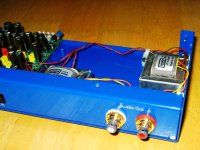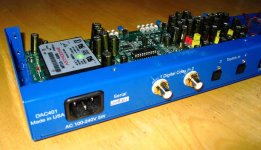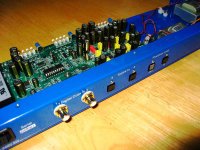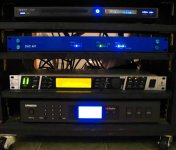Output is isolated and coupled by Jensen output transformers that are capable of 0.0001% THD.
All inputs and outputs from the box are either optical or isolated by transformers. No DC connections other than the power safety ground. Absolutely no hum.
All inputs and outputs from the box are either optical or isolated by transformers. No DC connections other than the power safety ground. Absolutely no hum.
Attachments
The equipment rack in my basement with Modified Oppo DVD player, DAC, Behringer DEQ2496 DSP equalizer in the processor loop, and a Sangean HD radio at the bottom. Not shown are the Popcorn Hour networked media player and plasma TV that comprise the four SPDIF inputs.
Attachments
rossl said:Two coax and Two Toslink inputs are good to 192K.
Nice work!
Did you use the Wolfson SPDIF receiver to MUX?
Did you use a 40mhz clock?
Cheers!
Russ
Russ White said:
Nice work!
Did you use the Wolfson SPDIF receiver to MUX?
Did you use a 40mhz clock?
Cheers!
Russ
No, I am using CS8416. I didn't use Wolfson because of the 176K problem.
The DAC clock is 80 MHz Crystek. You can't really see it very well in the pics because it is surrounded by tall caps.
rossl said:
No, I am using CS8416. I didn't use Wolfson because of the 176K problem.
The DAC clock is 80 MHz Crystek. You can't really see it very well in the pics because it is surrounded by tall caps.
Excellent!
I figured as much. I too find the CS8416 much more flexible and quite good. You actually can do 176K with the Wolfson, it just means jumping through hoops.
What sort of output IC did you fix your design around?
Cheers!
Russ
Russ White said:
Excellent!
I figured as much. I too find the CS8416 much more flexible and quite good. You actually can do 176K with the Wolfson, it just means jumping through hoops.
What sort of output IC did you fix your design around?
Cheers!
Russ
I'm using OPA1632D. four of them.
The symmetrical balanced filter stage I ended up with is flat at 10KHz and down to -0.5dB at 20K.
The -3db point is 175KHz.
-27dB at 1.25MHz which is MCLK/64...
Simulated, not measured.
The caps used for the filter are WIMA and they are the orange ones you can see in post 1017
I'm listening to the DAC in six bit mode now. I have burned a PIC to use nine bit mode and I listened to that for a while.
I'm driving the wife crazy because I play the same songs over and over when I do the tweaks and the listening tests...
Of course, I have to play it loud to hear all the dynamic range
Answers to some questions sent by email about the Prototype DAC pictured above.
First question. No, I didn't use J*cko H*mo's SPDIF input circuit for the coax inputs.
I did use the general philosophy that calls for the isolation of the received signal with transformer, then terminate and convert to logic level before coupling to the CS8416 with a cap.
Next question. No, I didn't provide for a DSD input to my DAC. In the setup pictured above, post 1024, the DVD player converts DSD to PCM. Adding a DSD input to the board would require another mux chip in front of the Sabre8. Also, I am not aware of a standard cable and connector for DSD.
Another question. It took me about 10 hours to hand solder the parts to the circuit board... Soldering the TSSOPs and LQFP is difficult and takes a lot of practice. So, it would not be practical to sell a bare board. I am looking into getting a professional assembly contractor to solder up a batch. This will be expensive.
First question. No, I didn't use J*cko H*mo's SPDIF input circuit for the coax inputs.
I did use the general philosophy that calls for the isolation of the received signal with transformer, then terminate and convert to logic level before coupling to the CS8416 with a cap.
Next question. No, I didn't provide for a DSD input to my DAC. In the setup pictured above, post 1024, the DVD player converts DSD to PCM. Adding a DSD input to the board would require another mux chip in front of the Sabre8. Also, I am not aware of a standard cable and connector for DSD.
Another question. It took me about 10 hours to hand solder the parts to the circuit board... Soldering the TSSOPs and LQFP is difficult and takes a lot of practice. So, it would not be practical to sell a bare board. I am looking into getting a professional assembly contractor to solder up a batch. This will be expensive.
Hi all,
I believe that, at least in the pro audio industry, the DSD standard connector would be a 75Ohm BNC...
I've read the whole thread and it seems to me that the focus of it is primarily audiophile/hi-end consumer use. While I have nothing against it, I would like someone to elaborate on already being implemented or potential pro-audio and mastering use of the Sabre chip.
My main questions that the thread doesn't cover (or dismisses quickly) are:
1) Is anyone here using a single Sabre chip in its 8-channel mode? Aside from being slightly inferior to its stereo mode when it comes to DNR\THD figures, what are your real listening notes and observations in comparison to the parallel stereo mode? Is stereo image the same? Bass/air fidelity?
2) What would be the best scenario of implementing a Word Clock circuit? Someone has briefly mentioned (Neo2k?) that in general sense anything that is not internal and not as physically close as possible to the chip would produce significantly inferior results. Is there a way to utilize Sabre's internal DPLL to interface with WC directly? What would be a setup to minimize the chip's performance loss in this regard? I'm not an electronic engineer, so I'm just thinking out loud.
3) Has anyone compared either Buffalo or Sabre eval board to pro-audio DACs from the main key players in the industry? Specifically:
- Lavry Gold/Blue/DA10
- Prism DA2 or ADA series (or even Orpheus)
- Weiss DAC1/2
- Cranesong HEDD
- UA2192
rossl: great build! If you don't mind sharing some pricing details, how much was it to build the rack (metalwork+coating)? How many units (just metalwork) did you do? This is my greatest stumbling block so far - to find someone to outsource metalwork to without parting with my car or living on beans for a year =)
Thanks to all for such a great pool of information!
Also, I am not aware of a standard cable and connector for DSD
I believe that, at least in the pro audio industry, the DSD standard connector would be a 75Ohm BNC...
I've read the whole thread and it seems to me that the focus of it is primarily audiophile/hi-end consumer use. While I have nothing against it, I would like someone to elaborate on already being implemented or potential pro-audio and mastering use of the Sabre chip.
My main questions that the thread doesn't cover (or dismisses quickly) are:
1) Is anyone here using a single Sabre chip in its 8-channel mode? Aside from being slightly inferior to its stereo mode when it comes to DNR\THD figures, what are your real listening notes and observations in comparison to the parallel stereo mode? Is stereo image the same? Bass/air fidelity?
2) What would be the best scenario of implementing a Word Clock circuit? Someone has briefly mentioned (Neo2k?) that in general sense anything that is not internal and not as physically close as possible to the chip would produce significantly inferior results. Is there a way to utilize Sabre's internal DPLL to interface with WC directly? What would be a setup to minimize the chip's performance loss in this regard? I'm not an electronic engineer, so I'm just thinking out loud.
3) Has anyone compared either Buffalo or Sabre eval board to pro-audio DACs from the main key players in the industry? Specifically:
- Lavry Gold/Blue/DA10
- Prism DA2 or ADA series (or even Orpheus)
- Weiss DAC1/2
- Cranesong HEDD
- UA2192
rossl: great build! If you don't mind sharing some pricing details, how much was it to build the rack (metalwork+coating)? How many units (just metalwork) did you do? This is my greatest stumbling block so far - to find someone to outsource metalwork to without parting with my car or living on beans for a year =)
Thanks to all for such a great pool of information!
Re: Denon DVD-1920 DSD MOD
Hello Russ,
I am in the middle of turning my DVD-1930ci into a top loader and was looking at the DSD connection you have. Should the wire be soldered at the vias or on the other side of the resistor or will it have no effect?
Russ White said:OK for those of you who don't mind risking a Denon DVD-1920 and want to get DSD out of it...
Here is how I am doing it:
There are three vias at DBK,DSD1,DSD2. Solder a tiny wire into each via.
I am not sure how I will run these to the panel, but for now just to test the DAC I just used allegator clip jumpers to wires which are installed in the DAC.
It actually sounds very good despite the makeshift wiring! It is definitely much better than the stock DAC, but that would not actually take much.
The DVD-1920 is much easier to modify than the DVD2910, so I would go that route personally.
Cheers!
Russ
Here is a picture of the wires soldered into the whiskers.
Hello Russ,
I am in the middle of turning my DVD-1930ci into a top loader and was looking at the DSD connection you have. Should the wire be soldered at the vias or on the other side of the resistor or will it have no effect?
Re: Re: Denon DVD-1920 DSD MOD
Hi,
I did mine at the vias, because there is already a series resistor at the chip on the buffalo.
Cheers!
Russ
khundude said:
Hello Russ,
I am in the middle of turning my DVD-1930ci into a top loader and was looking at the DSD connection you have. Should the wire be soldered at the vias or on the other side of the resistor or will it have no effect?
Hi,
I did mine at the vias, because there is already a series resistor at the chip on the buffalo.
Cheers!
Russ
promixe said:rossl: great build! If you don't mind sharing some pricing details, how much was it to build the rack (metalwork+coating)? How many units (just metalwork) did you do? This is my greatest stumbling block so far - to find someone to outsource metalwork to without parting with my car or living on beans for a year =)
Thanks to all for such a great pool of information! [/B]
Hi promixe
Get used to eating beans
Well, here is the bad news. I ordered just one chassis unit. It was expensive.
I spent a good amount of time designing it also.
As it was, I paid a lot for just the one chassis and tooling. For the price of just that... I could have gone and bought a decent used DAC.
But then... I already have two decent used DACs in my closet. I need to clean out the closet and sell some stuff. And, I wanted to make MY own DAC.
I didn't want to put in a big order of chassis units because I wanted to make sure everything fit, connectors screw in, and everything looked OK.
As it worked out, everything fit OK but I don't care for the paint color or the silkscreen.
In order to make it cost effective, an order at least 5 or 10 would make the cost of the tooling amortize out and bring down the per-unit price. Even then it will still be way more expensive than cheap china imported junk.
Changing the paint color on a new order costs nothing, but a new silkscreen is another tooling charge.
Re: Re: Re: Denon DVD-1920 DSD MOD
That is what I wanted to hear, thanks Russ. Got any idea on the Buffalo's availability?
Russ White said:
Hi,
I did mine at the vias, because there is already a series resistor at the chip on the buffalo.
Cheers!
Russ
That is what I wanted to hear, thanks Russ. Got any idea on the Buffalo's availability?
rossl said:Overall, the Sabre8 as I have it right now sounds better than the Anagram DAC. It is a very detailed sound and is neutral. The problem with op-amp IV converters and op-amp output stages is that the op-amps have a sound of their own. Transformers have a sound too, but the effects sound very neutral to my ears. The THD distortions do not sound "digital".
Neutral is good.
Didnt you remove the op-amps???
My Camelot DAC with the Anagram module is now being stored in the parts cabinet. I thought it was great a few years ago, but now technology has passed it by.
Which Camelot DAC do you have?
This one?
http://www.hometheaterhifi.com/volume_9_1/ces-2002-report-day-4.html
Also, which revision of the anagram module was in it? My guess would be the mk4, as used in the excellent Audiomeca Enkianthus DAC that i had the pleasure to listen.
If that's the case the Sabre is looking really great.
Re: Re: Re: DAC4392 + ESS Sabre: this is incredible.
What about a tube output stage? I believe that it's the best use of tubes
Also, I would look into using a digital volume control (Tent's new one looks interesting)
wildmonkeysects said:Output stage:
My current (pun!) favorite is a lowish value i/v resistor feeding a Lundahl Amorphous core transformer. Only works for DAC chips that have sufficient output voltage compliance, like the Sabre. Somewhat lowish output voltage, but very liquid, coherent, clean. Capable of ongaku.
I have been on both sides of the fence about transformers: many do indeed sound like the negatives attributed to them: lumpy, loose, steely, granular, lifeless, constricted, diffuse, fuzzy.
However, the Lundahl Amorphous core ones, like the LL1674 as an i/v are entirely another story. Relaxed ease, open, liquid, tight and defines low end, space and imaging galore, details without edge. I like! Look forward to fine tuning with the Sabre.
Cheers,
WMS
What about a tube output stage? I believe that it's the best use of tubes
Also, I would look into using a digital volume control (Tent's new one looks interesting)
wildmonkeysects said:
Indeed, althought it may be a small number outside of DIYland, there is likely interest in interfacing the output of a DF such as the PMD-100 or PMD-200. The thought of HDCD feeding the Sabre is a facet of what got my attention. In fact, the way this thread has many of us salivating, you would think there are some fleshy curves somewhere, but that is OT, and I don't operating theta. The PMD-100 would need glue logic either HW or SW to interleave it's output, but the PMD-200 appears to have an interleaved output mode available when in SW mode, and could interface 24/176 or 24/192 directly to the Sabre in it's current incarnation.
What are these PMDs?
I would love a HDCD decode added to (before right?) the Sabre DAC.
I actually have a Muse model2 dac (with hdcd decoding), which has an excellent psu section and my plan is to modify it, adding i2s and firewire input.
HDCD
Regarding HDCD I recommend ripping these disks to a harddisk (HD). Use the FLAC format (Free Lossless Audio Codec). But make sure you rip with DBPowerAmp with the HDCD DSP functionality. This decodes the HDCD disks to 24/44.1 format to the HD. What is needed is then a PC connected to some DAC capable of 24/44.1, or some other playback device (Logitech etc). I use a HTPC running Media Monkey for playback. HDCD capable DACs are more and more scarce, so this is a good solution.
RK
Regarding HDCD I recommend ripping these disks to a harddisk (HD). Use the FLAC format (Free Lossless Audio Codec). But make sure you rip with DBPowerAmp with the HDCD DSP functionality. This decodes the HDCD disks to 24/44.1 format to the HD. What is needed is then a PC connected to some DAC capable of 24/44.1, or some other playback device (Logitech etc). I use a HTPC running Media Monkey for playback. HDCD capable DACs are more and more scarce, so this is a good solution.
RK
Russ White said:
In reality the there is no voltage gain with the IVY as I have it configured , in fact there is slight loss.
All that really matters is the output is 2VRS at 0dB output.
Cheers!
Russ
Would it be possible to consider higher output (3 or better 4V+) in future revisions? without compromising the sound quality of course.
2V is low for me if not using a discrete preamp.
- Home
- Source & Line
- Digital Line Level
- ESS Sabre Reference DAC (8-channel)



